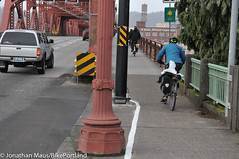
(Photos © J. Maus/BikePortland)
An electrical pole recently installed on the northern side of the Broadway Bridge has raised concerns because it narrows the opening of the very busy biking and walking path to a substandard width. Concerns have been raised by advocates, citizens, and even Multnomah County (who has operational jurisdiction over the bridge) says they opposed the pole’s placement.
“We agree this is not a good location, and that it creates a pinch point for sidewalk users.”
— Mike Pullen, spokesman for Multnomah County
Chris Smith, a City of Portland Planning Commissioner, a major proponent of streetcar, and a member of the board of the private non-profit Portland Streetcar Inc. (PSI, the private non-profit that builds and operates the streetcar), has called the pole, “an abomination” because it, “creates an incursion into a bike facility with no process or consequences” and a “a crash hazard” because it, “makes it difficult for cyclists to share the space with other users of the shared use path.”
Asked whether he thinks these concerns are valid, the executive director of PSI, Rick Gustafson (the father of Julie Gustafson, a project spokesperson for streetcar contractor Shields Obletz Johnson), said he agrees that the pole’s placement is “unfortunate” and that concerns are “valid any time you constrain bicycle access,” but that there were no other feasible — or affordable — options.
Smith wrote a letter (which was signed by BTA Executive Director Rob Sadowsky) to Gustafson and PBOT Director Tom Miller last month decrying the pole’s placement and requesting several mitigation measures to offset the negative impact the pole has on the bike network.
Mike Pullen, a spokesman for Multnomah County said County staff opposed a similar request from the streetcar project to place a pole in the south sidewalk of the bridge. In that situation, PSI and PBOT were able to locate the pole off the path by cantilevering it off the bridge railing.
“Our staff also raised concerns about the pole in the north sidewalk,” Pullen told BikePortland. But in that case, they were told there was no reasonable alternative location.
“We have a 4-foot, 10-inch passageway for bikes, so what’s the value of a 5-foot, 6-inch passageway? Is it $200,000?”
— Rick Gustafson, Portland Streetcar Inc.
“We agree this is not a good location,” Pullen added, “and that it creates a pinch point for sidewalk users.” (Pullen also said that given all the poles on the sidewalk, “one more pole should not make a substantive difference.”)
With so much agreement that the pole placement is problematic, why did PSI and PBOT move forward with it? (At about 4-feet 10-inches, the narrowed width is below PBOT’s own standard for bike-only lanes and this is a shared path.)
According to Gustafson, it’s simply an, “unfortunate trade-off.” While Gustafson echoed a PSI spokesperson’s claim that the location was chosen based on engineering feasibility, Gustafson also said it was also an issue of money:
“For a couple-hundred thousand dollars you could do it [move it somewhere else]… But you get to a point where you have to say, let’s go back and assess the value… How much per inch are you willing to spend? … We have a 4-foot, 10-inch passageway for bikes, so what’s the value of a 5-foot, 6-inch passageway? Is it $200,000?”
Gustafson has entertained the idea of moving the pole, “But they all involve an inordinate amount of money.”
When asked why the community wasn’t able to debate the merits of that expenditure, Gustafson acknowledged that PSI and PBOT made a mistake in not making the pole’s placement public prior to installation.
“I agree, that’s unfortunate. That’s a problem and it’s not how we typically operate or how we’d like to operate. It [the pole location] was a surprise to quite a lot of people.”
“You would never put a pole in the middle of a road. You shouldn’t be putting a pole in the middle of an MUP [multi-use path] — it’s just wrong.”
— Rob Sadowsky, BTA
One key issue that Chris Smith raised, and that has troubled citizen activist Joe Rowe (who has launched a Facebook page for the issue), is that the pole was initially intended to be placed in a different location, but project staff used the “change order” process to move it. That process wasn’t made public claims Smith.
Today, Gustafson denied that it was done through a change order, but he admitted that a change could have been made by construction crews and that the change wasn’t made public.
“There may have been an infield decision to move it over because of an issue with the [bridge] support member… I don’t have precise documentation. If that occurred that would be a mistake on our part to make a change in the field without alerting the bike community that we violated the standard bike lane widths… And that goes for the City and Streetcar; both were in agreement to place that pole.”
BTA Executive Director Rob Sadowsky says if they had an opportunity to review the plans prior to installation, “None of this would have happened.”
“You would never put a pole in the middle of a road,” added Sadowsky, “You shouldn’t be putting a pole in the middle of an MUP [multi-use path] — it’s just wrong.”
Gustafson says he and PSI are “as committed to the goal of 25% bike mode split as you are,” and he recognizes that to reach that goal, “we need to have outstanding facilities” for bikes.
As for the mitigation measures requested by Chris Smith to make up for the pole’s impact on the bikeway, Gustafson says he and Smith are actively working on them and they plan to bring a proposal of improvements to PBOT Director Tom Miller and then “figure out a way to fund it.”

